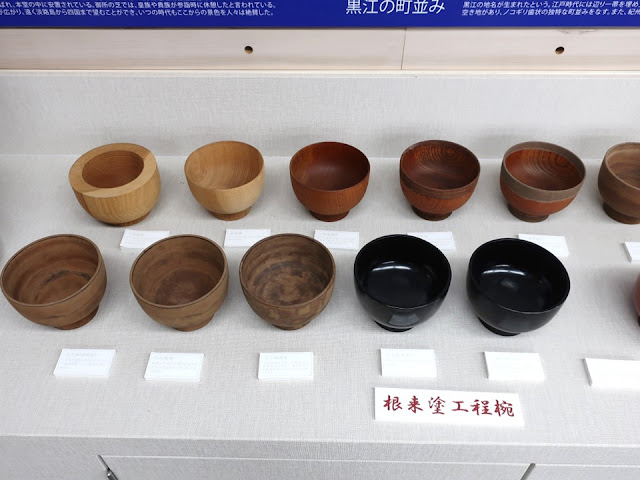The exhibition facility is in the building of Kishu Lacquerware Cooperative Association in Kuroe of Wakayama prefecture. Kuroe is around 70km south of the central Osaka. It has been a production center of lacquerware since medieval era. Its local tree (hinoki, Japanese cypress) has been used as material; soup bowls and so on have been made.
In the early 19th century, the
vendor of Kuroe came to my place in Chiba which is more than 600km away. The
lacquerware was expensive, so locals who wanted to buy them organized a group;
the members saved money and bought them. The lacquerware was expensive, but was
reachable.
和歌山県にある漆器の産地・黒江の紀州漆器協同組合の建物にある展示施設です。紀州は木が豊富な土地柄、しかも、大阪の中心部まで70kmと消費地が近いです。中世から紀州檜を使った木椀の製造が盛んでした。
私が読んでいる千葉県の名主の日記(江戸後期)にも紀州から椀を売りに来る話がでてきます。当時も高級品。椀講というグループを作って、お金を積み立てて買いました。庶民でも何とか手が届く高級品でした。
At the first floor, lacquerware is exhibited and some of them are sold.
1階は展示と販売のスペースです。
There is a lacquer tree by the entrance. The tree is scratched and the material of lacquer (sap) is collected.
玄関横には、漆の産地・岩手県浄法寺町から贈られた漆の木があります。
Exhibition roomⅠ、展示室Ⅰ
There are two exhibition rooms on the 2nd floor. In the Exhibition roomⅠ, traditional lacquerware is exhibited.
2階に二つの展示室があります。展示室Ⅰでは伝統的な漆製品が展示されています。
The manufacturing process and tools are also elaborately explained.
漆器の製造工程も、工具、写真とともに詳しく説明されています。
Lacquer is put again and again. Some are polished after the final lacquering in order to show its black groundwork. It’s a really elaborate work.
何度も塗って仕上げていくのですが、本塗りの後に、「研出し」といって下地の黒を見せる工程もあります。手が込んでいますね。
Exhibition roomⅡ、展示室Ⅱ
Modern lacquerware is exhibited. It is written that the biggest feature of Kuroe lacquerware is to put the astringent juice of the persimmon on the groundwork; it is used instead of expensive lacquer and lowers the price. It’s good for ordinary people.
モダンな漆器も展示されています。下地に高価な漆を使わず、柿渋などで下地を塗り、安価に製造するのが黒江塗りの最大の特徴だと書いてあります。庶民の味方ですね。
The manufacturing process of a bowl.
椀の形を作るところ(左上)から最終製品(右下)まで。
The map of Kuroe in 1935 shows the businesses of the buildings. Around five hundred buildings are related to the lacquerware business. Some make a bowl from a timber, some painted it and others sell it; various craftsmen and merchants are engaged in the industry.
500軒が漆器に従事しています。木から椀などの形を作る木地師から、塗り師、問屋まで様々な人が働いて、漆器を完成させています。
How do you like the bicycle above? It is colored by lacquer.
どうですか、この自転車。フレームも漆で塗っています。
There are old buildings in Kuroe, which attract tourists.
黒江には古い家が残っていて、町歩きも人気です。
Official
website: https://www.kishusikki.com/en/kaikan.html
https://www.kishusikki.com/03_kaikan.html
(in Japanese), accessed in November, 2023
Visited in March, 2023
Previous post (museum in the neighboring city): Arida city museum、有田市郷土資料館
Next post (museum in the same city):Kainan history and folklore museum、海南歴史民俗資料館










Comments
Post a Comment